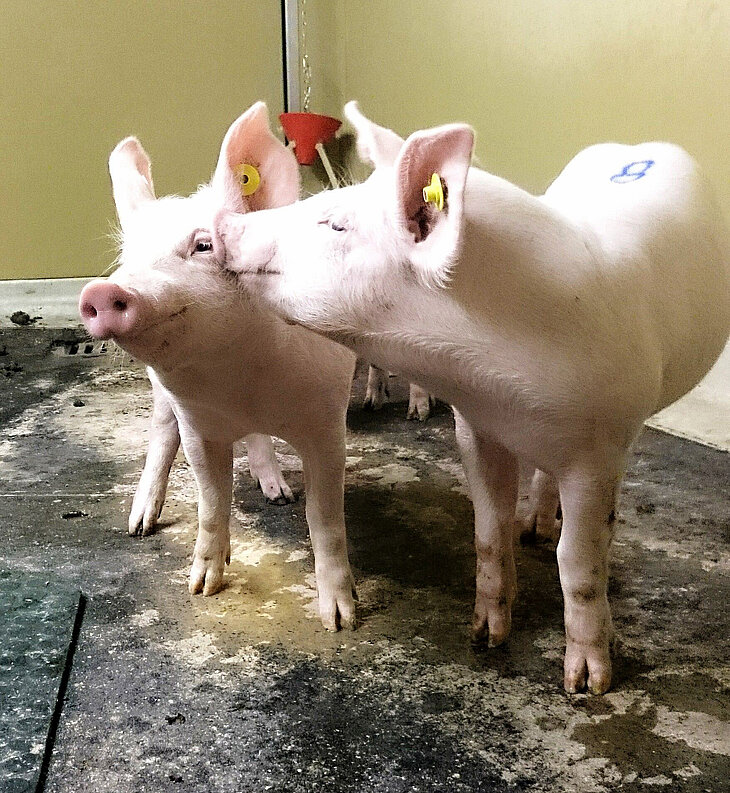Efficient entry into individual host cells is a prerequisite for a virus to spread in specific tissues or even in the entire organism. In order to develop innovative prevention and intervention strategies, it is important to know the molecular mechanisms of cell entry of viruses. Scientists from the Institute of Virology at the University of Veterinary Medicine Hannover (TiHo) published two studies on this topic in the scientific journals Journal of Virology and Virulence.
In the first study, cell cultures of animal origin were genetically modified in a targeted manner. The procedure is based on the CRISPR/Cas9 technique, also known as gene scissors. The researchers are now able to knock out genes for specific cell factors and investigate whether these factors are important for virus entry into the target cell. "Using these genetically engineered cells, we studied structures that pestiviruses use to enter pig cells. We focused on two pestivirus representatives: the classical swine fever virus (CSFV) and the atypical porcine pestivirus (APPV), which has only been known since 2016," said project leader PD Dr. habil. Alexander Postel. Atypical porcine pestivirus triggers shivering piglet disease in newborn piglets, in which the viruses infect certain cells in the brain and the piglets shiver uncontrollably.
Their studies of virus entry revealed that pestiviruses, depending on the species, appear to use very different target structures on the cell surface to enter the host cell. Nearly 20 years ago, researchers demonstrated that the APPV-related pestivirus, the animal pathogen bovine viral diarrhea virus (BVDV), can enter bovine cells via an antenna-like protein called CD46. The CD46 protein is the entry port not only for BVDV, but also for other pathogens, including various bacteria and viruses, such as certain human adenoviruses and herpesviruses, or vaccine strains of measles virus. Work at the Institute of Virology now shows that CD46 is also important for entry of the novel APPV into pig cells. Contrary to what was suspected for years, CD46 does not appear to play an essential role in CSF virus cell entry into pig cells. "How CSF virus enters pig cells remains a mystery for now, but we are working diligently to unravel it," Postel explains. The researchers published their findings in the Journal of Virology.
In a second study, the TiHo research group was able to show that the mechanism by which pestiviruses enter cells is much more complex than had been assumed for decades. "We investigated from which side BVD viruses infect so-called polarized epithelial cells of the bovine respiratory tract and on which side of the cell the virus progeny subsequently leave the cell," explains Institute Director Professor Dr. Paul Becher. Methodologically, for these studies, primary epithelial cells are obtained from lungs of slaughtered cattle and induced in cell culture to grow in cell assemblies that are very similar in properties to those in the living animal. "It turned out that the viruses can apparently penetrate the polarized lung epithelial cells particularly well through the 'back door' (basolateral), although here, in contrast to the apical cell side, hardly any CD46 is found on the target cells. We do not yet know the pathway by which this occurs. Newly formed viral progeny, on the other hand, are delivered very efficiently to the environment through the 'front door' (apical). This is optimal for excreting large amounts of virus via the lungs," Becher summarizes. The team published the results of the second study in the journal Virulence.
Original publications
Cagatay G, Antos A, Suckstorff O, Isken O, Tautz N, Becher P, Postel A (2021). Porcine complement regulatory protein CD46 is a major receptor for atypical porcine pestivirus but not for classical swine fever virus, Journal of Virology, DOI 10.1128/JVI.02186-20
Su A, Fu Y, Meens J, Yang W, Meng F, Herrler G, Becher P (2021). Infection of polarized bovine respiratory epithelial cells by bovine viral diarrhea virus (BVDV), Virulence, Vol 12, Issue 1, DOI 10.1080/21505594.2020.1854539
Contact
Prof. Dr. Paul Becher
University of Veterinary Medicine Hannover
Institute of Virology
Phone: +49 511 953-8841
paul.becher@tiho-hannover.de
PD Dr. habil. Alexander Postel
University of Veterinary Medicine Hannover
Institute of Virology
Phone: +49 511 953-8847
alexander.postel@tiho-hannover.de



